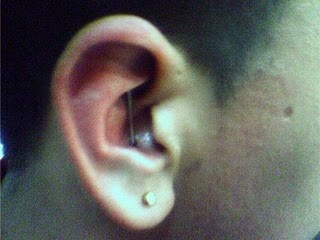If you need more ammo to convince your teenager that body piercing has its downside, consider these two words: lead poisoning.
 That’s one point I hadn’t considered among the pluses and minuses of piercing. (My thoughts ran more to nasty infections, nerve damage, lifelong scars, and chipped teeth.) Thanks to California—the trailblazer, as always, when the news concerns nipple rings or tongue barbells—I’m now aware that when puncturing body parts, I should demand 100 percent lead-free hardware.
That’s one point I hadn’t considered among the pluses and minuses of piercing. (My thoughts ran more to nasty infections, nerve damage, lifelong scars, and chipped teeth.) Thanks to California—the trailblazer, as always, when the news concerns nipple rings or tongue barbells—I’m now aware that when puncturing body parts, I should demand 100 percent lead-free hardware. This month, a new California law aimed at getting the lead out of jewelry expanded to include body-piercing jewelry and adult adornments. Lead is now verboten in piercing jewelry and is limited to less than 1.5 percent in regular jewelry that doesn’t have a protective coating. Last September, the state launched the nation’s toughest standards on lead in children’s jewelry, banning jewelry that is more than .06 percent lead by weight.
This month, a new California law aimed at getting the lead out of jewelry expanded to include body-piercing jewelry and adult adornments. Lead is now verboten in piercing jewelry and is limited to less than 1.5 percent in regular jewelry that doesn’t have a protective coating. Last September, the state launched the nation’s toughest standards on lead in children’s jewelry, banning jewelry that is more than .06 percent lead by weight. That action came after multiple recalls of lead-contaminated kiddie jewelry nationwide. The toxic metal can cause permanent brain damage and resulted in the death of a 4-year-old Minnesota child who ate a lead-tainted charm in 2006. The effects on adults are less dire but include impotence, high blood pressure, anemia, and kidney trouble. Skin contact usually doesn’t pose a big risk for teens and adults, says Michael Berriesford, supervising inspector for the California Department of Toxic Substances Control. But piercing is another matter. “We’re concerned about piercing jewelry because of the fact that the metallic posts come directly in contact with body fluids or blood flow and could carry lead directly into a person’s system,” he says. (That tongue stud just became even less attractive.)
That action came after multiple recalls of lead-contaminated kiddie jewelry nationwide. The toxic metal can cause permanent brain damage and resulted in the death of a 4-year-old Minnesota child who ate a lead-tainted charm in 2006. The effects on adults are less dire but include impotence, high blood pressure, anemia, and kidney trouble. Skin contact usually doesn’t pose a big risk for teens and adults, says Michael Berriesford, supervising inspector for the California Department of Toxic Substances Control. But piercing is another matter. “We’re concerned about piercing jewelry because of the fact that the metallic posts come directly in contact with body fluids or blood flow and could carry lead directly into a person’s system,” he says. (That tongue stud just became even less attractive.)Despite lots of ink surrounding the California law, the message doesn’t seem to be getting through. Last fall, state investigators bought and tested more than 600 pieces of children’s jewelry after the law went into force and found illegal amounts of lead in 18 percent of them. That included a pirate bracelet bought at a Universal Studios gift shop and necklaces bought at big retailers including Marshall’s, Macy’s, GapKids, Toys “R” Us, and Claire’s. One necklace, bought from a gumball machine at a Church’s Chicken restaurant in Oakland, had more than 600 times the allowable amount of lead. Investigators are now expanding their enforcement efforts beyond retailers, to manufacturers and wholesalers.
The rest of the country should follow suit. Michigan, Illinois, and Minnesota have passed legislation similar to California’s; other states, including Maryland, are pondering their own bans. But it would be much easier for manufacturers, retailers, and parents if there was a federal law covering all 50 states. A bill that would create federal limits for lead in jewelry is awaiting action in the Senate. But for now, it’s still body-piercer beware.
Berriesford says clues his investigators look for include low price, things made of metal that are heavy for their size, and things with a dull metallic luster. “There’s really no way a consumer can tell just by looking at it,” Berriesford says, “which is why we’re going through a significant amount of effort.”
If you, or your beloved offspring, are determined to pierce, California offers a comprehensive list (.pdf) of what’s safe. Think surgical-grade stainless steel or titanium, niobium, gold that’s 14 karat or higher, solid platinum, or dense synthetics such as Teflon (PTFE). Sterling silver, nickel, and other metals often used in inexpensive jewelry won’t do because they can spark allergic reactions.
No comments:
Post a Comment